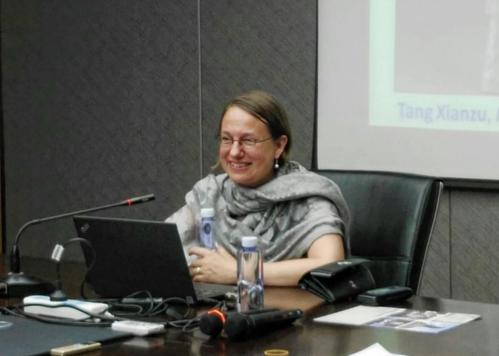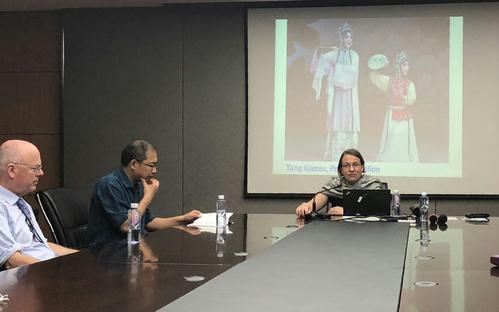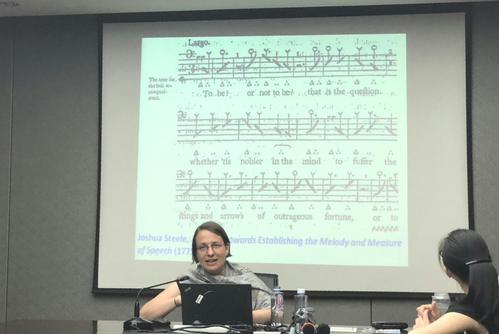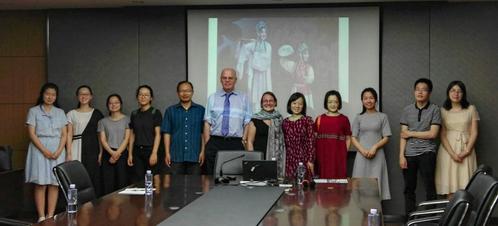On the afternoon of June 14, 2018, Professor Tiffany Stern, a professor on Shakespeare and Early Modern Literature at Shakespeare Institute, University of Birmingham gave a lecture entitled “Performances of Tragedies in the Shakespearean Era” at Room 201 of Building East 5, with the presence of Professor Hao Tianhu, host of the lecture as well as students and teachers of School of International studies. Tiffany Stern, a former professor on Early Modern Drama at Oxford University from 2005 to 2016, is a prolific writer of 9 books and over 60 papers and editor-in-chief of the Fourth Series of the Arden Shakespeare Complete Works and New Mermaid. In addition, Professor Stern and Professor Michael Dobson visited Center for Medieval and Renaissance Studies and had an academic discussion with students and teachers of SIS that morning.

Professor Stern began the lecture by illustrating the connotation of the word “tragedy” by comparing different titles of Shakespeare’s early play versions. Mr. William Shakespeare’s Comedies, Histories, & Tragedies, the first folio published in 1623, seems to be deliberately out of the argument about whether “plays” or “works” should be used as titles (Since Ben Johnson, a famous playwright once proudly claimed, “My plays are works while others’ works are plays”). Titles of the quarto published in Shakespeare’s lifetime included Richard III, a tragedy, King Lear, a historical play and Hamlet, a tragic-historical play, which proves there’s no clear boundary between tragedies and historical plays back then.
After that, Professor Stern showed the stage settings of the Shakespearean-era tragedies. “Tragedian” and “comedian” nowadays are used for writers of tragedies and comedies, but for actors and actresses of tragedies and comedies in the Shakespearean era. Besides, the colors of stages were exquisite, e.g. black curtains usually implying tragedy. For instance, Hamlet in Hamlet seemed to be drowned in unfathomable sorrow as he was in black, foiled by the black curtain. Red stages meant blood. The complementarity of black and red curtains highlights an immense tragic atmosphere. Apart from that, play names were hung above the stages to be seen clearly by the audience. Sometimes subtitles were added to indicate contents, just like the title of the book printed on the top of every page as a reading tip.

Then, Professor Stein elaborated the ways of performing tragedies in the Shakespearean era with vivid pictures and captions. Actors and actresses of tragedies usually wore a kind of high boots named buskin, while those of comedies wore socks of special shape and a saying “Socks to ankles, and boots to thighs” is used as a compliment for wonderful performances. Besides, some verbs for actors’ gait, such as stalk, jet and strut, and some body languages, e.g. thumbs-up for praise and one finger touching lips for silence lively outlined the performances and reproduced the performing effect in the Shakespearean era.

In the end, Professor Stern exemplified the specific tones and intonations in Shakespeare’s plays. Take Hamlet as an example, one of its lines “To be, or not to be” is marked with iambic intonation, so actors need to follow the marks in performance. Watching performances in the Shakespearean era, audience sometimes carried a table book (table for short) to write down good or new words or sentences, e.g. “the ghost of Hamlet” for something ubiquitous, for further reference and the words were erasable. Professor Stern also mentioned Richard Burbage, a popular actor at that time described by his contemporaries as “having unparalleled passion in both lines and actions”. After that, she compared Shakespeare’s plays with traditional Chinese operas, Tang Xianzu’s in particular, and hoped that both of them could step forward by learning from each other.
Professor Hao Tianhu ended the lecture with a concise summary and had a discussion with Professor Stern in terms of genres and scripts of Shakespeare’s plays. The audience also raised questions or shared ideas about stage colors, note book qualities, space limitations and comparisons between Chinese and foreign plays. Lively and rich in academic value, the lecture created an easy atmosphere for audience to acquire knowledge and think deeply, rounding off in warm applause.

Written by Meng Shiying and photographed by Feng Yuchu & Meng Shiying
Translated by Li Jia and Zhou Xingchen
Edited by Xu Xueying



